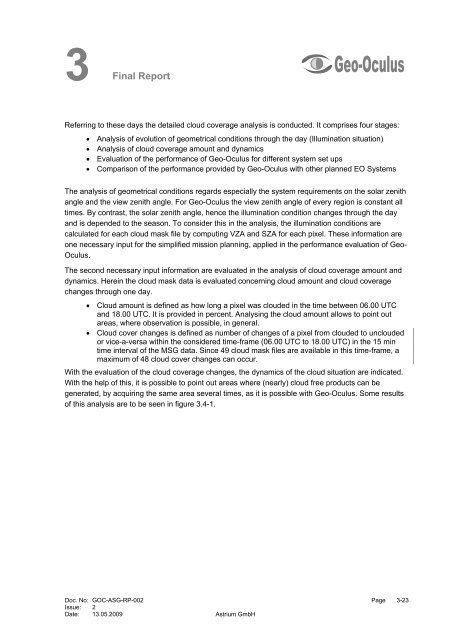4 Final Report - Emits - ESA
4 Final Report - Emits - ESA
4 Final Report - Emits - ESA
You also want an ePaper? Increase the reach of your titles
YUMPU automatically turns print PDFs into web optimized ePapers that Google loves.
3 <strong>Final</strong><br />
<strong>Report</strong><br />
Referring to these days the detailed cloud coverage analysis is conducted. It comprises four stages:<br />
• Analysis of evolution of geometrical conditions through the day (Illumination situation)<br />
• Analysis of cloud coverage amount and dynamics<br />
• Evaluation of the performance of Geo-Oculus for different system set ups<br />
• Comparison of the performance provided by Geo-Oculus with other planned EO Systems<br />
The analysis of geometrical conditions regards especially the system requirements on the solar zenith<br />
angle and the view zenith angle. For Geo-Oculus the view zenith angle of every region is constant all<br />
times. By contrast, the solar zenith angle, hence the illumination condition changes through the day<br />
and is depended to the season. To consider this in the analysis, the illumination conditions are<br />
calculated for each cloud mask file by computing VZA and SZA for each pixel. These information are<br />
one necessary input for the simplified mission planning, applied in the performance evaluation of Geo-<br />
Oculus.<br />
The second necessary input information are evaluated in the analysis of cloud coverage amount and<br />
dynamics. Herein the cloud mask data is evaluated concerning cloud amount and cloud coverage<br />
changes through one day.<br />
• Cloud amount is defined as how long a pixel was clouded in the time between 06.00 UTC<br />
and 18.00 UTC. It is provided in percent. Analysing the cloud amount allows to point out<br />
areas, where observation is possible, in general.<br />
• Cloud cover changes is defined as number of changes of a pixel from clouded to unclouded<br />
or vice-a-versa within the considered time-frame (06.00 UTC to 18.00 UTC) in the 15 min<br />
time interval of the MSG data. Since 49 cloud mask files are available in this time-frame, a<br />
maximum of 48 cloud cover changes can occur.<br />
With the evaluation of the cloud coverage changes, the dynamics of the cloud situation are indicated.<br />
With the help of this, it is possible to point out areas where (nearly) cloud free products can be<br />
generated, by acquiring the same area several times, as it is possible with Geo-Oculus. Some results<br />
of this analysis are to be seen in figure 3.4-1.<br />
Doc. No: GOC-ASG-RP-002 Page 3-23<br />
Issue: 2<br />
Date: 13.05.2009 Astrium GmbH

















